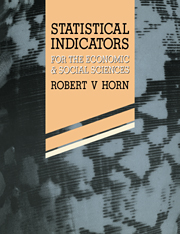Book contents
CHAPTER 5 - SOCIAL APPLICATIONS OF INDICATORS
Published online by Cambridge University Press: 27 October 2009
Summary
‘Social indicators’
The term ‘social indicators’ has long been used for statistics that are relevant for the analysis of the situation in a particular social field or for society as a whole, similarly as statistics for economic analysis are referred to as economic indicators. We need not enter here into the debate about a precise definition of ‘social’, beyond noting that in some ways it overlaps with ‘economic’ because social demands are subject to economic restraints and because economic processes are linked to their social and societal environment. At most we can say that some indicators belong mainly to the social sphere (e.g. school performance, sporting performance), while others (e.g. exchange rate, productivity) are mainly economic phenomena, or that economic indicators deal mainly with things and money while social indicators are more concerned with people.
Social indicators, in this general sense, go back thousands of years. The early enumerations of the population mentioned in the Bible, and ancient registers of land titles, had a social element of ascertaining the population structure and military preparedness connected with the economic purpose of establishing a tax base. The British poverty studies since the seventeenth century, and two centuries later the family budget studies of European statisticians (Brussels Congress, 1853), mark the beginning of social reporting and the application of indicative statistics. They set the pace for the government collections published in yearbooks that translate social phenomena into the neat numerical language so persuasively developed for economic analysis.
- Type
- Chapter
- Information
- Statistical IndicatorsFor the Economic and Social Sciences, pp. 146 - 205Publisher: Cambridge University PressPrint publication year: 1993



